Journey across the iconic rooftops of Paris and beyond with the teams of Benuts and experience their visual effects work on Les Infaillibles:
© Vincent Frei – The Art of VFX – 2024
Journey across the iconic rooftops of Paris and beyond with the teams of Benuts and experience their visual effects work on Les Infaillibles:
© Vincent Frei – The Art of VFX – 2024
In 2018, Bryan Grill showcased the visual effects work of Scanline VFX made on Black Panther. Following that, he worked on X-Men: Dark Phoenix, Free Guy, and The Gray Man. Now, he joins us to talk about his latest project, the highly anticipated sequel to Beverly Hills Cop.
How did you get involved on this movie?
I had been interested in being the overall VFX Supervisor on film for a while now. Netflix thought BHC: Axel F was the perfect opportunity to take that next step in my career.
What was your feeling to be part of this iconic universe?
Eddie Murphy is well Eddie Murphy! 48 Hours, Trading Places and Beverly Hills Cop are the trifecta in fun! I am a huge Little Rascals fan and seeing Eddie do Buckwheat on Saturday Night Live just made me so happy. It was you know kismet.
How was the collaboration with director Mark Molloy?
The collaboration with Director Mark Molloy was a beautiful ark. Because he wanted the movie to be grounded and film it like you would have in 1984, his vision was to shoot as many practical effects and stunts as humanly possible. So there was a lot of planning with all the Heads of Departments on the film so we could realize that for him. The Visual effects department supported the other departments when there were safety concerns, location limitations, and continued support in post. Mark and I really connected in post during editing. Any problems or ideas he had he would float to our department and we worked together with Editor Dan Lebanthal to come up with the best solution for the story. We were able to collaborate and create a movie that featured 1984 storytelling with 2024 tools.
How did you organize the work with your VFX Producer and amongst the Scanline VFX offices?
As overall visual effects supervisor I worked with Production Visual Effects producer Victor Medel at Bruckheimer production offices in Santa Monica. We were fortunate to have Micah Gallagher as Scanline VFX Supervisor working with both VFX Producers Lisa Spence and Syed Apsar. Since Scanline was Main VFX Vendor we looked to them to create the talent pool from the offices available to work on our show. I believe we had teams in Los Angeles, Vancouver and Seoul mixed in with artists from all around the world.
Can you describe the process of integrating visual effects into the action scenes?
The Process of integrating the visual effects into the action scenes was dictated by what we could or couldn’t shoot practically. For instance in the Go4 parking meter vehicle chase, for safety reasons special effects and stunts added training wheels on the front so the 3 wheeled vehicle would not tip over easily since stunts would be pushing the limits driving at its highest speeds and taking very sharp turns. There were also limitations on where the Go4 was allowed to be – like the stairs at 2 Rodeo and the sidewalk in front of the Armani Store where Eddie crashes the Go4. For the 2 Rodeo stairs and the crash we shot elements of stunts actually driving down stairs and crashing. We ended up using those elements as the base for the final VFX work.

The Helicopter chase sequence was based around Fred North’s flying of the real helicopter in four Los Angeles locations. We needed to make sure our actors were featured so it felt as if they were the ones in the helicopter and not Fred. In order to achieve believability our SPX Supervisor Elia Popov and his team built a helicopter buck matching the real one exactly. This was then put on two different types of gimbals. The first was on a blue screen stage where we could shoot the actors when they were flying high in the air and another on that same gimbal but on the drivable gimbal called the Go Mobile. The Go Mobile put our helicopter at street level controlled by someone driving it and another operating the movement of the helicopter buck. This allowed us to film our actors in the same environment as our real helicopter while getting the necessary performances from our actors.
These techniques ring true for the other action sequences throughout the film. We smashed a real truck through a set piece of a mansion and the Wilshire shootout crashing Eddie’s Bronco. Visual Effects connected all the pieces together either removing rigs, cameras and crew or adding damage, environments, bullet hits, muzzle flashes and more.
What were the main challenges faced in enhancing the action sequences with visual effects?
I think the main challenges enhancing the action sequences with visual effects was the budget.We needed to work closely with the filmmakers figuring out the best way to tell the story but without overindulging in VFX.
Sometimes films rely too much on the VFX, or story changes create larger holes to fill creatively. Because we worked hand in hand with all the departments it was important we all executed our parts to the fullest.
How did you ensure that the visual effects blended seamlessly with the practical stunts and live-action footage?
I think the only way you can ensure that the visual effects blend seamlessly with practical stunts and live-action footage is to be a team player. Knowing what is needed to be achieved and putting forth a plan to make it happen is the key. In visual effects there are a few sayings I like to keep telling myself, like, “You’re only as good as your last comp“ and, “Get what you need not just what you can.”Trusting your team and being able to communicate works very well when you want to do the best job you can.

What specific visual effects techniques were used to enhance the chase scenes in the film?
There were no special techniques used to enhance the chase scenes in the film. Similar to how they did things in 1984, we stuck to tried and true solutions. For example our Eddie head replacements ranged from full CG rendered heads to a single frame photography tracked on in 2D. We did whatever it took to help tell the story the best. I am a big tech fan and love to use new techniques when possible and have been able to in the past. The closest I think was using some new AI roto tools that helped separate crowds on sidewalks from plates that did not have a helicopter and putting them into the footage with the helicopter because we could not have people on the streets because of safety reasons.

Can you talk about any particular action scene where visual effects played a crucial role?
I think the opening of the film in Detroit and the Snow Plow Chase is where visual effects played a crucial role. We shot that chase sequence in Detroit during the beginning of winter which was great because if we had snow it would work for the story. Unfortunately, there was no snow so we had to wet down the streets and dress the streets and sidewalks with fake snow when we could. The rest of the time we added snow drifts and falling snow throughout the sequence. We shot Eddie in the snow plow on an LED stage in Los Angeles, which worked out great for the close-ups and the mid shots. We also shot Eddie close ups on a green screen to make it look like he was driving around Detroit in his awesome Chevy Nova. These shots needed to integrate with the other production footage shot in Detroit with Eddie’s stunt double Robert Doqui driving in and around the city. Additionally, we incorporated the footage of Eddie from our LED Shoot into the Practical Stunt driving footage of the Snow Plow Chase. Even the hockey game in Detroit incorporated a real RedWings game at Little Caesars Arena in Detroit while Eddie’s scenes were shot at the Galen Center on USC Campus in Los Angeles.

How did the use of visual effects contribute to the overall pacing and intensity of the film’s action scenes?
The visual effects contribution to the overall pacing and intensity of the film’s action scenes was immense. For example the final Mansion shootout was a collaboration with our special effects team and props. We shot in a real mansion and were not allowed to mess it up so shooting practical effects safely would take time. We had to pick the times we would use practical effects and the rest would be VFX. Editorial set the pace cutting the sequence together and then VFX would add all the bullet hits including debris and smoke, blood hits, and splatters, muzzle flashes, and a consistent balance of smoke from the truck crash destruction throughout the sequence spearheaded by NetFx.The editorial timing of bullet hits were crucial to the final scenes intensity Including the final shootout between Grant and Axel which was done by Scanline.
What were some of the most innovative visual effects used in the movie?
I think the most innovative visual effects in the movie were done during the pepper spray sequence. It would not be possible to shoot pepper spray (or water for that matter) into Eddie’s eyes. So to deal with that issue we dressed an Evian mist spray bottle to look like the pepper spray bottle. Eddie was ok with the soft mist and then makeup would add some viscus gel around his eyes to give a sense of wetness.These 2 elements alone worked great for editing purposes but the director had envisioned more spray and drips during the sequence. Our visual effects gurus at Scanline came up with a great way of incorporating thicker spray and tracking on drip and water elements to Eddie’s face helping to round out the story needs.
How did the visual effects team collaborate with the stunt coordinators and action choreographers?
Visual effects and Stunts supervised by coordinator Mike Gunther worked very well together helping realize the final choreography of the action sequences. For the helicopter sequence we took the time early on to do previs with Halon based on the storyboards. Director Mark Malloy had a vision to shoot the whole run from different cameras and Halon was able to create the long chase sequence and then run that sequence from multiple camera setups.We had static cameras, chase cameras, cameras rigged to the helicopter, cameras rigged to the police car chasing, static cameras on cranes, sidewalks and end of streets all totaling seventeen different views to output. From there, based on notes from the Director, Halon would do an edit incorporating the cameras the director liked the best at the different times in the sequence.This laid the groundwork for Mike Gunther’s Stunt Driving team and Fred North’s helicopter team to reconstruct the sequence from the ground up, slowly figuring out where and when the cars would move as the helicopter would be flying down the street. It was a ballet that needed to be repeated in real time and be perfect time and time again in order to be able to shoot all the cameras the director wanted for the final edit. In order to execute this stunt safely the communication between all of the production teams had to be spot on.

Were there any scenes that were originally intended to be practical but were enhanced or replaced with visual effects? If so, why?
The only scene that really needed a bit of visual effects enhancement was the parking garage scene. Jane’s BMW gets pushed off the ledge of a ten story parking garage.This was executed practically but with only the budget to do one time. Elia and his special effects team figured out how to push a real car off the building and dangle from a steel tow truck cable.The production literally had to stop traffic on the 10 freeway in Downtown Los Angeles in order to do this stunt since the actual parking garage was right next to the freeway. Could you imagine driving home from work and witnessing a car falling off a building? Crazy right? Exactly why they had to stop traffic. Because there were mounted cameras on the actual BMW, we knew we would need to replace parts of the car. When the actual stunt was done it was a bit more violent than we had hoped as the convertible top was ripped off when it hit the end of the line so to speak. Since our actress was only supposed to get scared and not hurt or killed in the story we ended up replacing the the BMW with a CG version and adjusting the trajectory and the weight of the car for the final shots.We also needed to invent a few more full CG shots creating more terror as the car gets pushed closer and closer to the edge. Not to mention putting back the moving traffic on the freeway.

Can you discuss the role of pre-visualization in planning and executing the film’s action sequences?
We had not planned to do much pre-visualization in the planning of this film because it was to be shot all practically. As discussed above, talking about the helicopter sequence we used previs to inform the director and DP Edu Grau where cameras would work the best.
How did you maintain a balance between practical effects and CGI to keep the action scenes grounded and realistic?
The beauty of shooting a movie with practical effects is having great reference from the shoot. Sometimes in an all CG sequence you have to figure out how the cars will drive and how the helicopters would fly.A lot of research goes into pulling that off if you are not shooting it practically.The one shot we really needed to research was the helicopter crash.We were able to get great footage with the help of Fred North but crashing a helicopter goes against everything a great pilot wants to do. We found a few crashes online but they were so violent and dangerous we had to find that sweet spot of realism. So for the story, Bobby Abbot, played by Joseph Gordon Levitt, was a helicopter pilot in the past but had crashed, leaving him with no confidence in his piloting abilities. The helicopter crash needed to be realistic but also not too violent, so that both Bobby and Axel could walk away from the crash without being hurt. Scanline’s animators and effects artists came up with the perfect hard landing in my opinion.

Were there any unexpected obstacles or surprises during the post-production phase related to visual effects?
While some are more extensive than others, I think there are always last minute requests or notes that happen on all films. I think on our film it was mostly to add more snow drifts in the Detroit snow plow chase, for example, which meant going through another round and amping up what we already had started. There was also some cosmetic work that needed to be done and last minute trailer shots, but it was all par for the course.
How did you approach the creation of digital doubles for the actors in high-risk stunts?
The three actors we needed for digital doubles were Jane, Bobby and Axel. Digital doubles are standard in movie making in 2024. Sometimes you wonder how movies ever got done before digital doubles, hmmmmm? Before the digital double, movies were made in a way where you saw just enough to believe and keep you in the story. That’s why I love suspense and horror because you can get the same reaction of emotions with music, sound and inserts of blood and a knife but never actually see the knife go in and rip the guts out of the victim.
Looking back on the project, what aspects of the visual effects are you most proud of?
Looking back on this project I am particularly proud of the invisible and realistic effects in the film, especially the helicopter sequence. Right before Bobby and Axel take off from the top of the roof at the beginning of the sequence was the last time they actually sat in a real helicopter. All subsequent shots were either blue screen buck shots or helicopter buck shots on the Go Mobile on the streets of Downtown Los Angeles. Even the shots on the Go Mobile we had to work on replacing parts of the windshield and adding flickering and reflections of the rotors.

Tricky question, what is your favorite shot or sequence?
What is my favorite shot or sequence? Hmmm good question… I really love the Go4 pepper spray shots. I thought they came out great and that part is so funny. But most of all I am proud of the Visual Effects teams that we worked with. Everyone did such a great job listening and creating seamless work.
How long have you worked on this show?
I started work on the show July of 2022, until May 2024 with a six month hiatus gap from writers and actors strike.
What’s the VFX shots count?
Our final count was a total of 1040 shots. I believe ScanlineVFX did around 500 shots. About 350 + shots were handled by or in-house compositing team consisting of Jeff Kalmus, Bonjin Byun, Carey Villegas, and Joel Farrel. Lola VFX helped out with some cosmetic fixes late in the game – thank you! Scanline and Eyeline Studios did most of the heavy lifting but our in-house team did amazing work doing some hard head replacement shots and the normal camera, rig and boom mic removals, not to mention split screens and retimes and anything else our Filmmakers needed. Our in-house Production team also included Victor Medel (VFX Producer), Virginia Wilson (VFX Production Manager), Isabella Tallerino (VFX lead coordinator), Anthony Pinkett (VFX coordinator), Tianhy Armstrong (VFX PA), Nick Curdy (lead VFX data wrangler), Ned Wilson (2nd unit VFX supervisor) and Joe Carson (VFX editor). Last but not least a big thank you to Gentle Giant Studios and Jargon Entertainment.
What is your next project?
I am not sure I can say at this point. But is will be a Netflix Film.
A big thanks for your time.
WANT TO KNOW MORE?
DNEG: Dedicated page about FIRST MAN on DNEG website.
© Vincent Frei – The Art of VFX – 2024
Ever wondered how Snip Snip slices through the post-apocalyptic world with style? Important Looking Pirates pulls back the curtain on their visual effects work for the series, Fallout:
WANT TO KNOW MORE?
Ahmed Gharraph & Måns Björklund: Here’s my interview of Ahmed Gharraph (VFX Supervisor) & Måns Björklund (Executive Producer) at Important Looking Pirates.
Important Looking Pirates: Dedicated page about Fallout on ILP website.
Jay Worth: Here’s my interview of Production VFX Supervisor Jay Worth.
Prime Video: You can now watch Fallout on Prime Video.
© Vincent Frei – The Art of VFX – 2024
Dive into the captivating visual effects world of Atlas with the teams of Scanline VFX and discover how they brought an epic mecha to life on an exotic planet and crafting intense combat scenes!
WANT TO KNOW MORE?
Lindy DeQuattro: Here’s my interview of Lindy DeQuattro, Production VFX Supervisor.
Netflix: You can now watch Atlas on Netflix.
© Vincent Frei – The Art of VFX – 2024
Witness the USS Enterprise in its most gripping scenes. Ghost VFX‘s work on Star Trek: Strange New Worlds features visual effects that enhance every moment of the ship’s trials:
WANT TO KNOW MORE?
Ghost VFX: Dedicated page about Star Trek – Strange New Worlds – Season 2 on Ghost VFX website.
© Vincent Frei – The Art of VFX – 2024
Discover the visual effects work crafted by the teams of Digital District that turned scenes filmed in a Spanish water tank into views of Paris for the Netflix film, Sous la Seine (Under Paris):
WANT TO KNOW MORE?
Arnaud Fouquet: Here is my interview of Arnaud Fouquet – Overall VFX Supervisor – MPC.
Netflix: You can now watch Sous la Seine (Under Paris) on Netflix.
© Vincent Frei – The Art of VFX – 2024

Back in 2021, Matthew Bramante elaborated on the visual effects work on the first season of Sweet Tooth. Following that, he joined the Paper Girls series. Now, he’s here to discuss the final season of Sweet Tooth.
After discussing his involvement with the inaugural season of Sweet Tooth, Rob Price moved on to projects like Midnight Mass, The Midnight Club, and Gen V.
For the past 12 years, Danica Tsang has been with Zoic Studios, where she has produced visual effects for a multitude of series including Once Upon a Time, The Twilight Zone, The Right Stuff, and, most prominently, Sweet Tooth.
How did you organize the work between you?
Matt Bramante // My role as the production VFX largely consisted of working with the creative team of showrunner, writers, directors, producers and other department heads to breakdown the scripts and plan how and where VFX were needed in prep, often involving overseeing previs, then seeing that through shooting of all main unit, plate unit and element photography. Once the show hit post, it was critical that with some of these large VFX scenes, that VFX was considered early in the cutting process, that involved me working with our showrunner Jim to postvis and help selecting plates to make sure the Zoic team had what they needed to execute on those shots.
In addition, on Sweet Tooth Season 3, we needed to really open the scope of what VFX needed to provide. Stepping into the setting of winter in Alaska, shot mostly in the summer in Auckland New Zealand. This required a new and changing environment multiple times per episode, and rarely did we have locations we could use for those. To help us, we stepped up our use of the LED volume for this Season, which also was run by my small New Zealand team of artists and engineers.
Rob Price & Danica Tsang // Working with Matt Bramante and Danica Tsang from prep to post pays off big for the VFX team. Having the same VFX team throughout the show’s entire run helped with trust and communication. Planning in prep directly impacted our ability to maximize what we achieved in post through multiple overlapping Seasons. Being spread across the globe, having supervisors and producers working on set and in the VFX house throughout helped us spread the collective knowledge.
What is your role on set, and how do you work with other departments?
Matt Bramante // I have always found that my favorite VFX work always starts with as much practical and in-camera work as possible. Which means, any given effect starts with a conversation about what we can and can’t do practically. Often after receiving a script or an outline, I would walk over to art dept and sit with our prod designer and hash out what they could build, or with locations to find if there was a location we could shoot plates at, or with the hybrids team, SFX team, etc to start with as much practical as possible. Of course with much of Season 3, we had to go outside to Alaska, which involved a whole new set of challenges that fell largely to the VFX department to solve.
For this we used the LED walls as an answer to as much as we could. Often shooting plates for the wall, but in some cases generating CG backgrounds or matte paintings with comped moving elements, or even miniatures. This required a lot of work with the art and locations team to make sure we could get access to snowy hills and mountains for all of that plate photography before the summer arrived, or build miniatures we could photograph and build out our environments. Beyond that, when we needed to really open up the scope, we would rely on CG set extensions, or add CG vehicles or buildings to our high wide helicopter or drone plates. And in a few cases we needed to build CG snow environments to be comped with plates of vehicles. But overall, a goal I had set out in the early days of this Season was to have every shot start with a piece of photography, even if we replaced it all, or replaced most of it. This required a lot of planning between departments and a lot of small splinter and second unit shoots to pick up various pieces.
As far as on set work, I had a great team of local on-set supervisors, and data wranglers to help cover the various units and shoot days. Each one would help breakdown, plan, and previs their block with me and then be there on the day to see that things were executed according to plan, or adjust that plan as needed. In addition, they would often help with comping and tweaking the LED content on the day to adjust to notes given by the directors and DoPs.
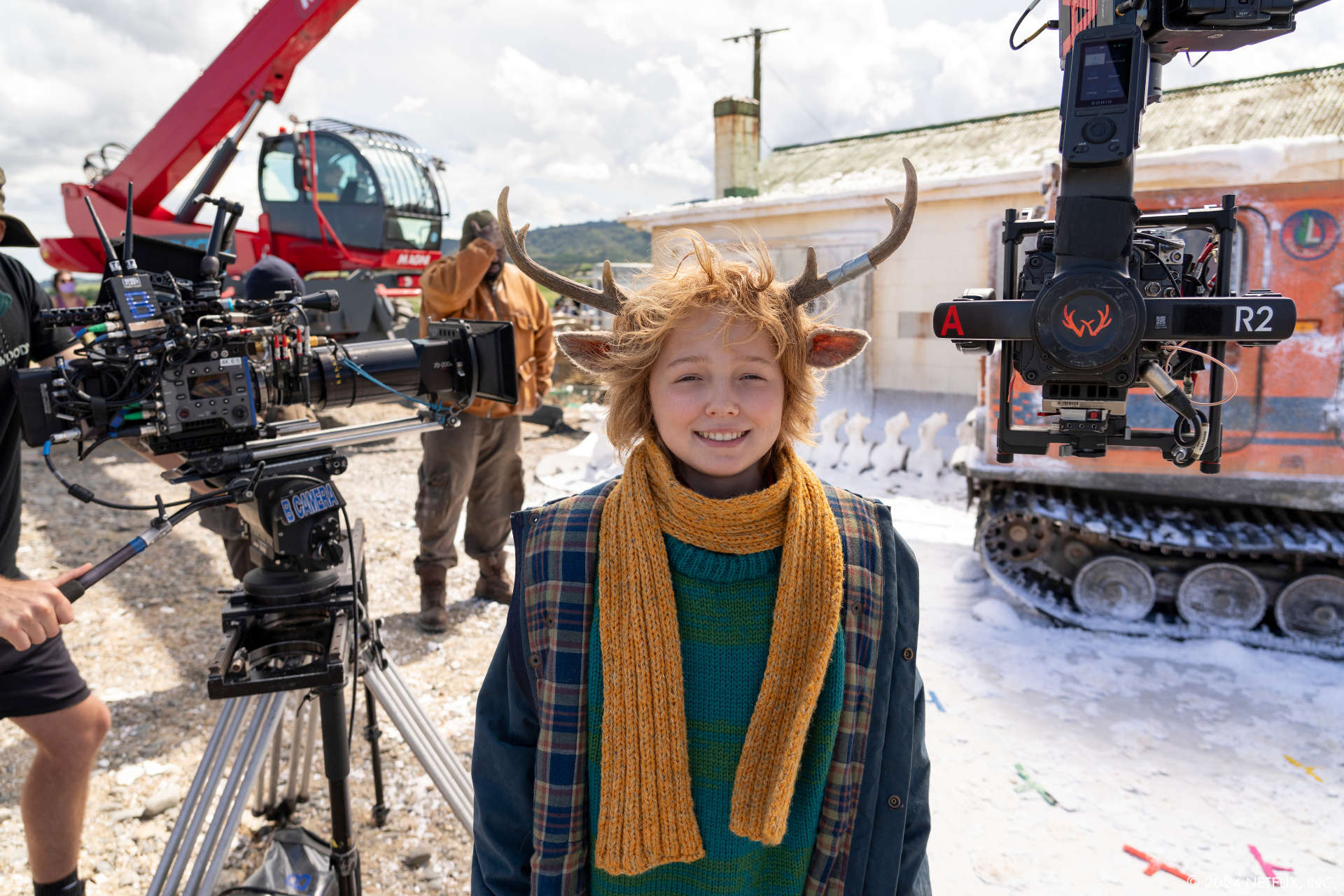
Can you walk us through the evolution of visual effects from the first Season to the final Season of Sweet Tooth?
Matt Bramante // From the beginning, our showrunner Jim expressed his goal to achieve a practical approach to VFX wherever possible. So even back then, we were looking to how to use whatever camera tricks, practical SFX, locations and set builds we could as a starting point to build the world and characters. And that was definitely a large consideration heading into Season 3.
The biggest thing I would say that evolved in our process was the use of LEDs to expand upon those “in-camera” VFX shots. I think at one point I counted up the amount of led sets in episodes 307 and 308, and found that those two episodes have more led sets than all of Season 1 and Season 2 combined. In addition, Season 3 saw the introduction of miniatures into our VFX tool kit, again another instance of an “in-camera” solution to VFX needs. But it’s critical to point out that even though there were plates shot of those miniatures or environments, the Zoic team really made the shots come to life with all their work. Often that involved adding CG parts to the environment, adding snow and atmosphere in the air, or comping additional elements of our characters on green screen.
Rob Price & Danica Tsang // The overall evolution was about finding newer ways to meld what we can do with other departments. There was always a sense of everyone trying to up their game. For example, in earlier Seasons we needed to animate ear movements in emotional scenes for Gus. By Season 3, the puppeteering team had refined what they could achieve with animatronics, which led to some fantastic practical performances, allowing us to put our efforts into other effects like expanded environment and creature work.
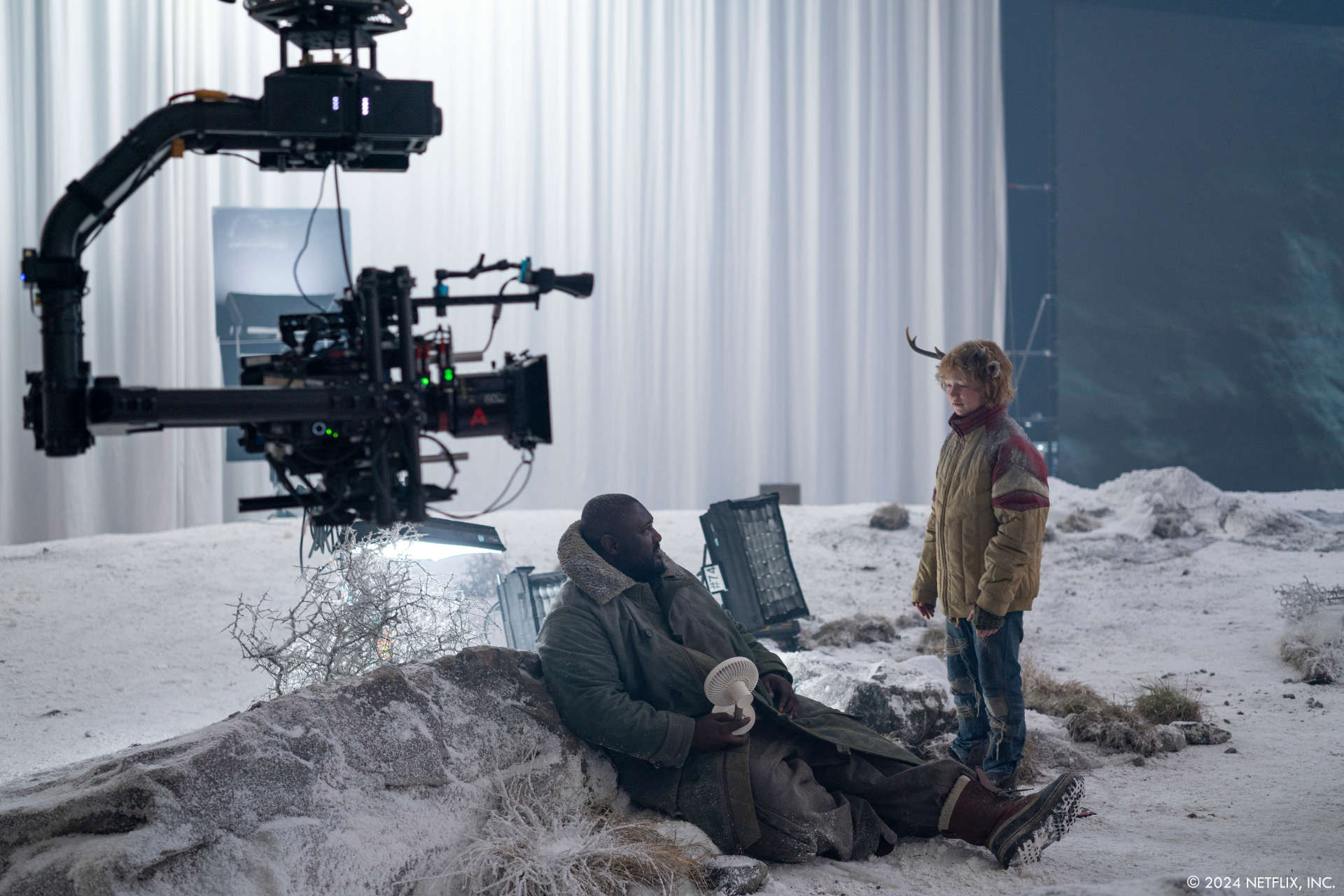
What were some of the major challenges you faced in creating visual effects for the final Season compared to previous Seasons?
Matt Bramante // Alaska is of course the biggest thing, as mentioned before, my goal was to shoot plates wherever possible to use either on the LED walls or as plates for final VFX shots, or even as matte painting elements for CG environments. When I arrived in Auckland, it was just at the very end of winter, but even winters in Auckland are very mild, rarely getting below 40 or 50 degrees. So with scripts only for the first few episodes, and rough outlines and descriptions of what would be in 303-308, Dave our DoP and I went down to the South Island, outside Queenstown to shoot helicopter plates over the Nevis range. Everything from high and wide establisher plates, to ground level plates, to montage pieces just for editorial.
301 presented us with a nice opportunity, to use our first look at Alaska in a practical way to help set a tone and an aesthetic for the rest of the Season. One scene in particular being the snowmobile chase with birdie. By doing that largely practically, it helped to give us a language for the rest of the series to match to and made the viewer more likely to buy into some of the more VFX or stage bound scenes. That 301 snowmobile chase was shot at a cross country ski field on the South Island. All wide shots were done practically with stunt doubles, but the close ups of the actors were shot on LEDs back at the stages months later.
While we were shooting the stunt work, we were able to fit in more drone plates and driving plates out there at the ski field. We even stayed overnight in a cabin on the side of the mountain to shoot sunsets and sunrises while a storm descended on us. Those plates with the helicopter work over Nevis made up the majority of our Alaska photography for the Season. Which then needed to have CG vehicles or buildings added to them. And of course in a few instances, the Zoic team needed to make a fully bespoke CG shot of Alaska too.
Rob Price & Danica Tsang // The scale we needed across the board. This story begins in Yellowstone and ends in Alaska. We needed a wide range of different environments, vehicles, and characters along the way. Each episode has its own unique challenges and looks, unlike most episodic projects where you might be within one location for several episodes or a Season.
How did the visual effects pipeline for Sweet Tooth change or improve throughout the series?
Rob Price & Danica Tsang // It’s always our goal to do the next one better than the last, whether it’s new ways to consolidate more of our pipeline within a single package like Houdini, develop tools in Nuke, previsualize the work earlier, or organize teams more effectively.
In Season 3, we implemented a new manifest system utilizing Houdini and Shotgrid to track assets and build shots procedurally, which our CG Supervisors, Bryan Davies and Tristan Patrick, managed. Incorporating more environments, characters, and effects in Houdini simplifies all the elements that need to be handed off to downstream departments. We also developed even more previsualization in Unreal. Tools like this don’t just help us in post, but help all departments when used effectively in prep.
Our team has always been a significant size, with over 200 artists working on the show at any given time. In order to effectively communicate with each other, we are constantly updating how we utilize tools like Shotgrid to move the vast amounts of data into achievable tasks. Our VFX Associate Producers, Tara Kahn and Dallis Anderson, were a big part of helping us manage the team and keep it operating at capacity. All of this helped us achieve shots with greater complexity this Season.
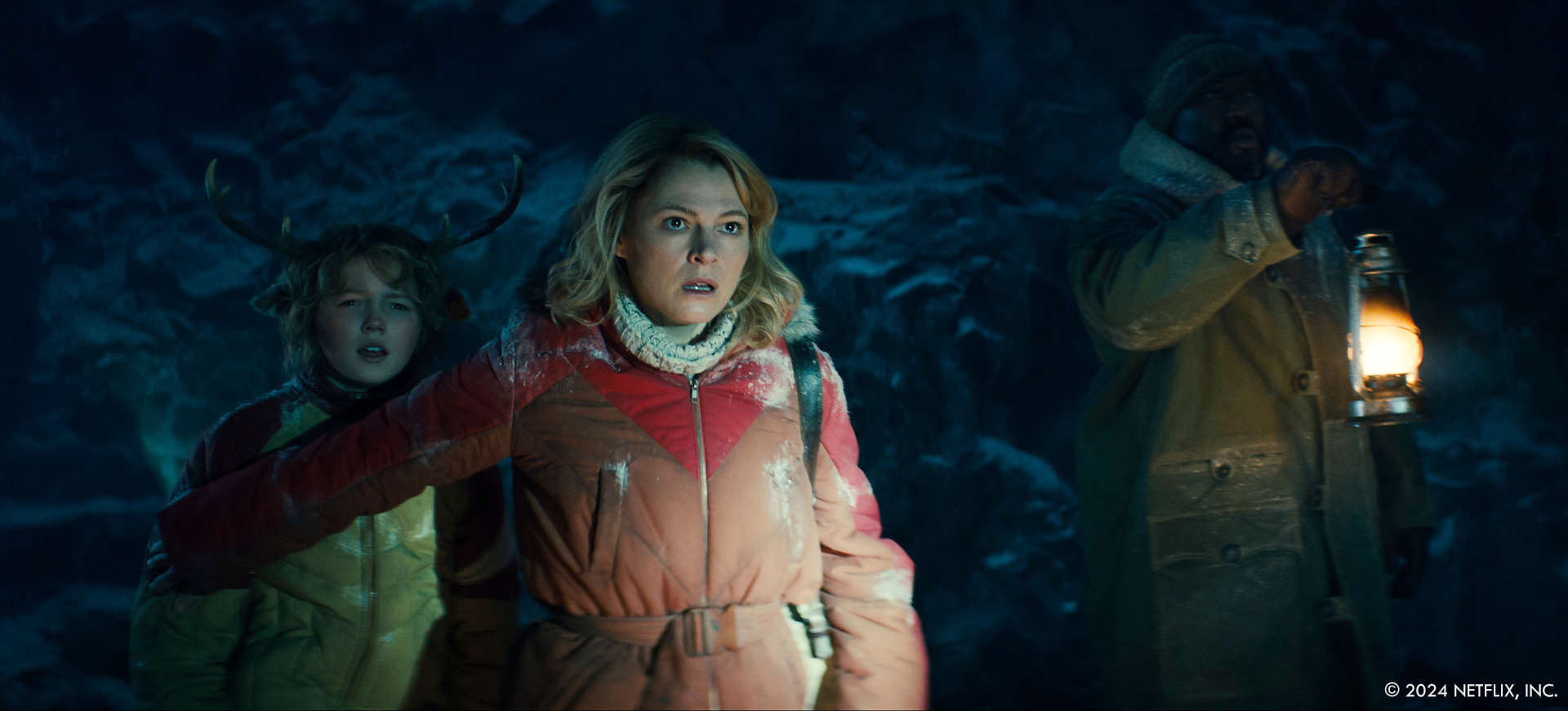
In the final Season, what specific techniques or technologies did you use to enhance the visual effects compared to earlier Seasons?
Matt Bramante // The LED walls were critical to this Season. Not only because they allowed us to bring a lot of locations back to stage, but they also allowed us to avoid using green screens and blue screens unless we really needed it. In previous Seasons we had just tip toed into using LEDs, they were only used in specific scenes or as an answer to car driving work. And that was still the case in Season 3, but we grew the use cases immensely, whole scenes were staged with just a floor and a few small set pieces in front of the LED. For example most of the Arctic expanse scenes through the Season, the post avalanche in 301, some of the 303 boat scenes, the snowy canyon in 307, the beast chase in 308, the 308 pubba forest dream, as well as all the windows in the Alaska outpost all relied heavily on LEDs. By episodes 307 and 308, we started putting photographed miniatures on the wall, which expanded out our options for how to achieve scenes like the Arctic canyon when Jep, Birdie and Gus are looking for the cave mouth.
Rob Price & Danica Tsang // Much of what we do is standard at this point—collecting scans and data on set and jumping to virtual assets for environment, vehicles, and characters. This Season, we added utilizing miniatures for environments like the Arctic church set, and vehicles for the chase sequences. This meant we needed identical versions of our assets as full-scale, miniaturized, and digital, so that we could push the scope of what could be achieved across the board. Shot to shot, you never really know which of those three you see.
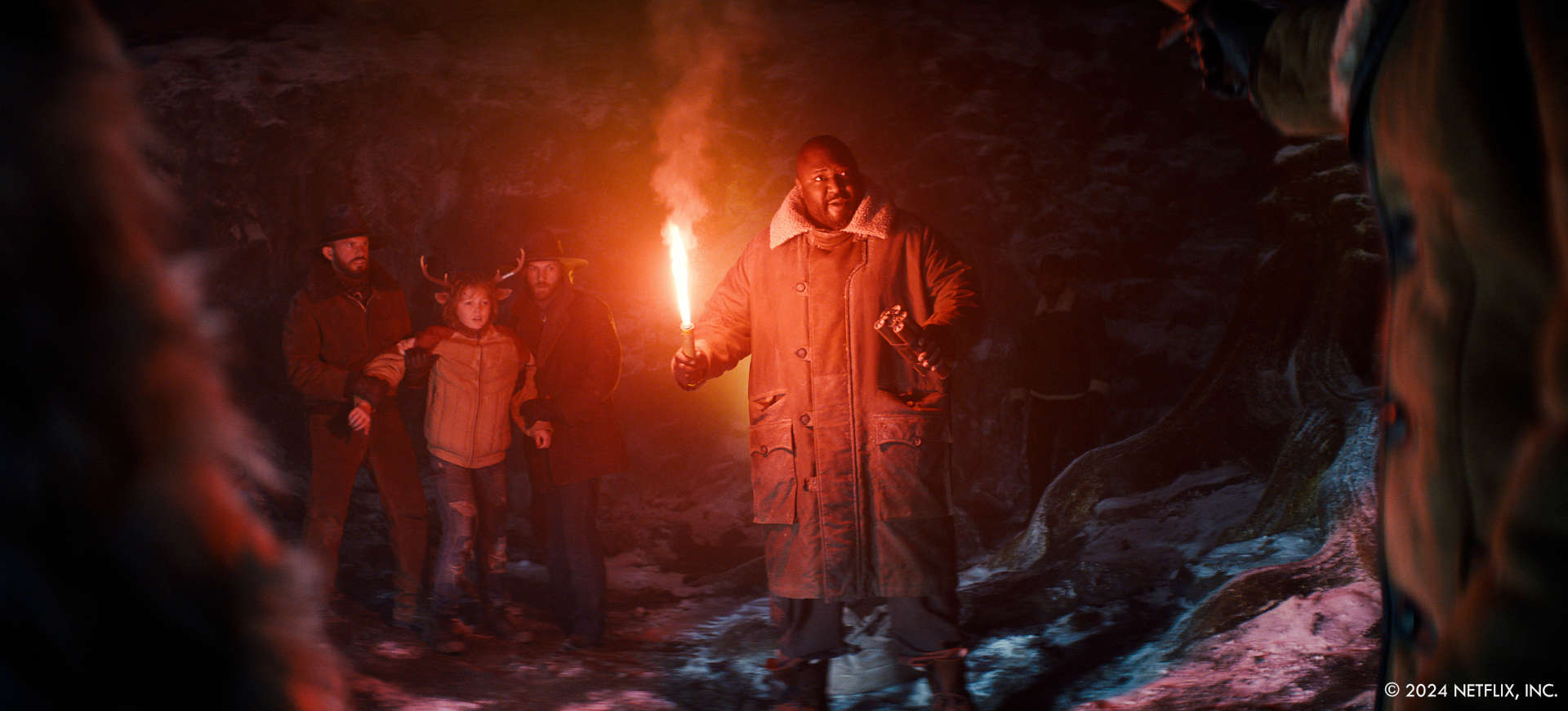
Can you tell us about the collaborative process between the VFX team and other departments to bring the children to life on screen?
Matt Bramante // Season 3 has a lot fewer hybrid kids than Season 2 did, but it’s notable what the new hybrids were. The wolfboys, which start as largely practical animatronic masks, but have a lot of VFX enhancements from the Zoic team. Going all the way back to the end of Season 2, we knew these guys were coming. Jane O’Kane, the hybrids team designer started working up designs for what they could practically do. We talked a lot about how large structure changes, like jaws opening and closing would be difficult for VFX to do, but the small soft tissue articulation like lip curl, nose sniff, etc are places we could help. So the wolf mask prosthetics were designed to have animatronic jaws, and some minor nose scrunch and lip articulation. Then in post, the Zoic team added a lot of 2D articulation to the muzzle, nose and lips to really give them life and take away any mechanical feeling left in the mask. As we got into the later episodes and the wolf boys become more viscous, the Zoic team also enhanced the teeth by adding extra drool to the mouth.
The other new hybrids this Season consisted of a couple of new born babies. The mouse baby in 302, the wolf-boy babies in 303, the baby hermit in 306, and the walrus baby in 308. Each has a different approach. The mouse baby has a digital set of ears for shots with a real baby, as well as a full non-animatronic prop baby, that needed digital enhancement to bring to life. The baby hermit needed digital nose, ears and antlers. The walrus baby and wolf-boy babies both had similar approaches. Both with pupeteerable mouths that could open and close, and a grab hand that could articulate, but needed digital manipulation for eyes, cheek, nose, lip articulation, etc. These struck the same balance as the full wolf-boys, using the practical for the large structural articulation and allowing the digital side to give them life with soft tissue animation.
Rob Price & Danica Tsang // It’s about how we can enhance the children further. The big ones this Season were the Wolf Boys. Their practical effects makeup was outstanding, and the stunt actors performed amazingly. We focused on adding facial performance with 2D animation and cleanup of stunt-related equipment to ensure the audience never questions whether this is a realistic hybrid child they are looking at. Adding some extra touches like drool helped to expand the character’s ability to emote and perform. We also worked closely with the stunt team on how we approach each scene. Each stunt had slightly different costumes, make-up, and safety rigging needs that we needed to accommodate for.
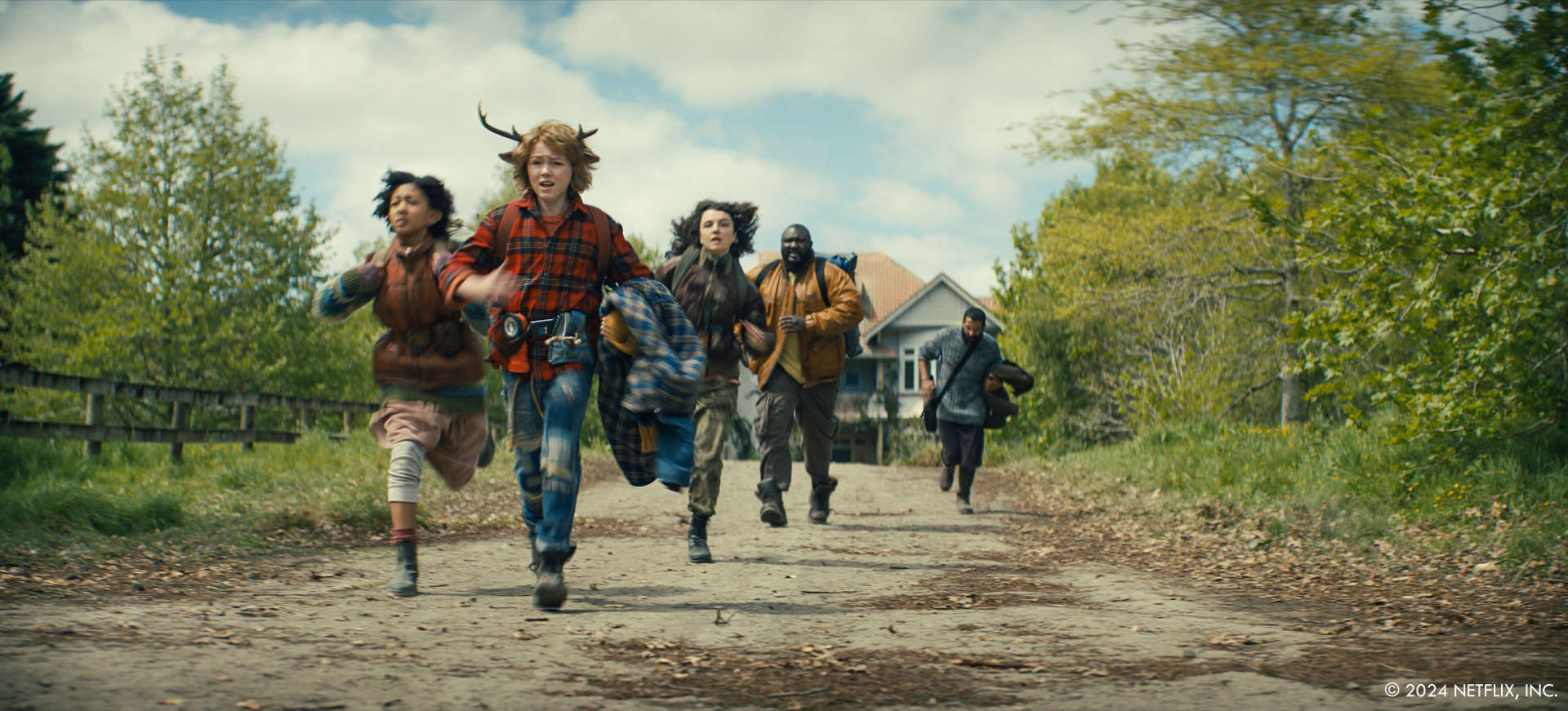
Were there any particular inspirations or references you drew from when designing the children’s visual effects?
Rob Price & Danica Tsang // As most of our work this Season focused on the wolf boys, there were copious references for how wolf muzzles deform and change shape during different emotions. Most of our wolf boys show their emotions through aggression, but occasionally we have some tender moments. We needed a full range of animation.
Sweet Tooth features a variety of unique environments. How did you approach creating and enhancing these environments using visual effects?
Matt Bramante // Much of this starts with the amazing art department team, Nick Basset the production designer and Al Gillies the senior concept artist as well as the whole team of art directors and concept artists are fantastic at taking real world reference and finding the particular flourish to give it the Sweet Tooth fantasy aesthetic. So a lot of the VFX work is really building off that very strong foundation.
One scene in particular that fell to us in VFX to figure out was the vision of pubba in the burnt out forest in 308. We had gone around in circles for weeks on what that should look like. Real world reference looked too apocalyptic, there weren’t any real locations to shoot that at. So we had earmarked it early on for LED stage work. We went out and shot plates of a real pine forest, but none of it had the right feeling. So we started throwing together previs versions of it, building out a digital forest and just changing the color palette, moving trees around, moving the light around, until we hit just the right balance of surreal painterly aesthetic and realism. Something hopeful but desolate, rather than scary and apocalyptic. The final renders for that scene were literally dropped into the environment minutes before the cameras rolled.
Rob Price & Danica Tsang // We always discuss what we need for the story first. Many of our environments were on a grander scale this Season, so we start with concept art. The art department created multiple ideas of what we could see, and building off that, we folded those ideas into what we had on location or the stage builds. This Season had a lot of different arctic environments, and multiple stage builds needing buildings, caves, or tundra extensions. Elements like vehicles shot on location often needed complete CG snow environments constructed around them. Some locations with smaller areas dressed with practical snow would also require expanding to help tell the story, including digital weather and interactive elements within the landscape. A wide range of techniques helps with visual variety and overall believability in environment work.
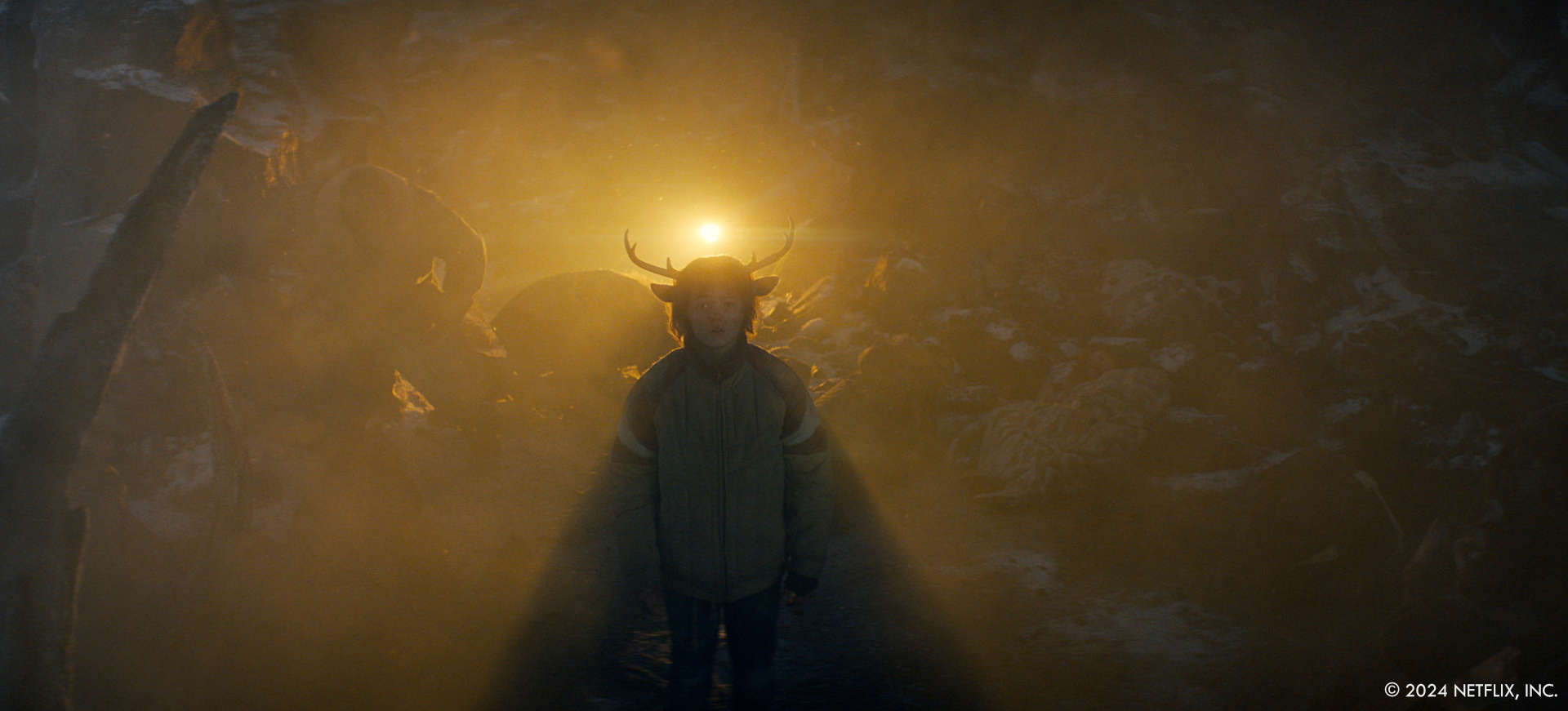
Did you face any specific challenges when creating the post-apocalyptic world of Sweet Tooth in terms of visual effects?
Matt Bramante // Thankfully, as the Season headed further out into the wilderness, we were able to work on a different sort of post-apocalyptic aesthetic from previous Seasons. Jim had always loved the idea of nature reclaiming the environment, but as we headed further and further north, there wasn’t a lot of human infrastructure for nature to reclaim, so we could largely focus on beautiful natural and fantastical environments.
In the case of Alaska, this meant lots of snow capped mountains and hills of snow. But also, as we journey out to the cave mouth, Jim and Nick came up with the idea of a canyon that acted almost like a maze our heros would have to find their way through. After looking for places we could shoot something like that, we quickly found there just wasn’t a real version of that environment. Running out of time, and our set build resources committed largely to the building of the interior cave, we elected to build a few miniature canyon walls. We shot BG plates and wide shot plates of those walls and put them up on the led screen, and that ended up being our canyon. A largely in camera approach to this scene. It then fell to the Zoic team to comp a few high and wide shots with digital canyons or extensions off the miniature plates to give us the full scope and scale we were looking for. Overall it was a really successful approach to something that would have been a world of green screen otherwise.
Rob Price & Danica Tsang // Expanding a world into a post-apocalyptic world was a little simpler this Season. Our story takes us further and further into the wilderness, and further away from man-made structures needing to be broken down. This Season was all about creating large landscapes with scale and vastness. Small remnants of the world are often left behind, but much fewer than in Seasons one and two that had large post-apocalyptic cityscapes.
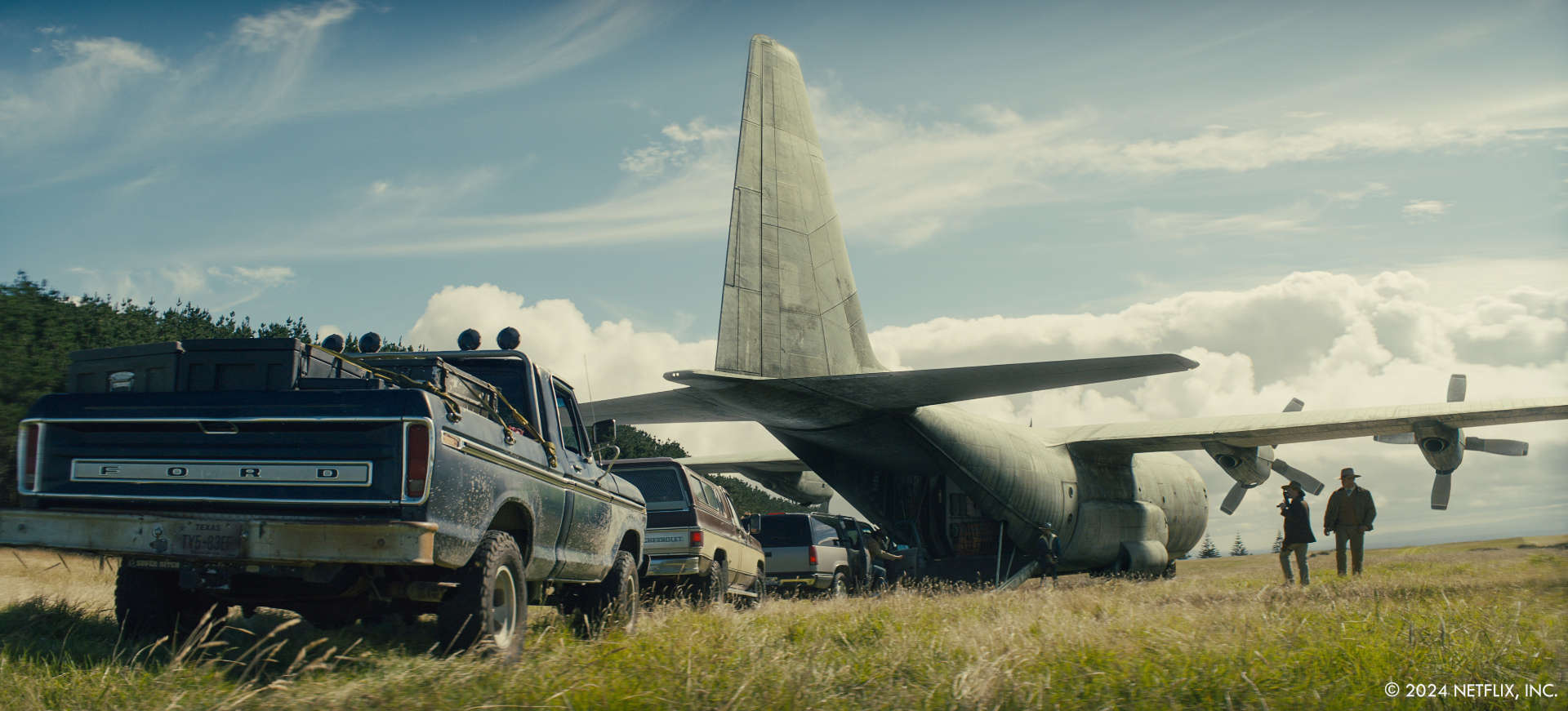
How do you balance practical effects with CGI to maintain the show’s aesthetic?
Matt Bramante // A lot of both. My general approach is close-ups want to be more practical, wides want to be more digital. We never wanted to have a wholly digital shot, instead we’d shoot a plate and add and enhance. This gave us a lot more grounded camera work, and gave us lighting, animation, and look reference to match into. The Zoic team did a handful of huge shots that have very small pieces of plate in the comp, so they’ll were largely building out huge CG worlds for those. But the goal was to let those wide shots really act as big singular moments rather than rely on it for whole scenes. The goal of the VFX on sweet tooth was to use VFX for the things we couldn’t do in any other way.
Rob Price & Danica Tsang // We always aim for a realistic aesthetic for this show’s VFX, which lends well to balancing shots with special and visual effects. It usually comes down to a conversation about time or budget for the best solution in a scene.
The final Season has more elaborate action sequences. How did you approach creating VFX for these action scenes?
Matt Bramante // Previs was critical, especially on the beast chase in 308. That sequence was shot over three units and 10 days. That began with a previs sequence we worked up even before we had a full script. Once Jim was happy, I worked with Toa our producing director and Axel our scheduling producer to break down how and where each piece would be shot.
We had a quarry with some dirt and rock walls we sprayed snow onto for our stunt driving work, then we had all the closeups with actors on LED stage, and finally we had a miniature “beast” truck built for the roll at the end of the scene and for the top of the scene when the beast bursts through the sign. We started with a map of the quarry, and camera directions and camera mounts based off of the previs. Listing out how each shot would be done, hard mount to vehicle, tracking vehicle, drone, etc. In the original schedule, we were set to shoot the ext stunt work with splinter unit a week before the stage work on LEDs, so our team would have time to shoot BG plates, process them and put them up on the wall. But best laid plans often go awry as they say, that went out the window and of course those all got smashed together, and we’d shoot the plates the night before and then they’d need to be up on the wall the next day. Which largely worked, but eventually we started getting into places where the practical location was limited. We wanted to see the tops of the walls of the canyon, which simply didn’t exist on location. So we had to build out a digital canyon and make CG plates for the driving work. Which worked out really well.
Finally, we got to the crash and the beast roll. Early in the process, Jim and I had talked about options for this, and he really liked the idea of using a miniature for the roll. It was funny, we started looking at overcranked videos of toy cars flipping over and just loved the aesthetic. So one day, Jim came into the office with a big RC tank toy to test the idea. Cut to, Jim, Dave and I throwing an RC tank into SFX snow with a little camera shooting 1000fps. And it looked pretty awesome, and it also was one of the most fun days of RnD I’ve ever had on set. Once the concept was proven, it then fell to Justin our miniatures builder to build up a mini beast. Which in final form was fully RC and could drive up to 70kph, had fully working headlights, magnetic detachment points for the large crane and other parts of the truck. Overall it was a beautiful build, so beautiful, that on the day, the only person who could actually throw it was Justin himself. We had 2 days with the miniature. One of driving shots, close ups on tank treads, knocking over the sign, and the start of the roll which we largely were doing in a controlled way. Then on day 2 we’d load it up and threw it into snow banks. All of it shot in phantom at 1000fps, rolling through sodium bicarbonate (baking soda), and it turned out great. Just like most other effects on the show, it then also fell to the Zoic team to take these all home. All of these needed digital snow, atmosphere, and light enhancement, because even with the miniature headlights, they just weren’t powerful enough to look like big headlights at 1000fps. Once it was call cut together, it made for a really exciting sequence.
Rob Price & Danica Tsang // Early planning is key. Many shots had multiple layers of complexity: dynamically moving cameras, animation, set extensions, interactive weather, and environment effects all in the same frame. I sit down with our Digital Effects Supervisor John Fukushima to discuss the best approach for each challenge individually. It’s rare that one shoe fits all; a lot goes into deciding on a shot level what package is best for a particular effect.
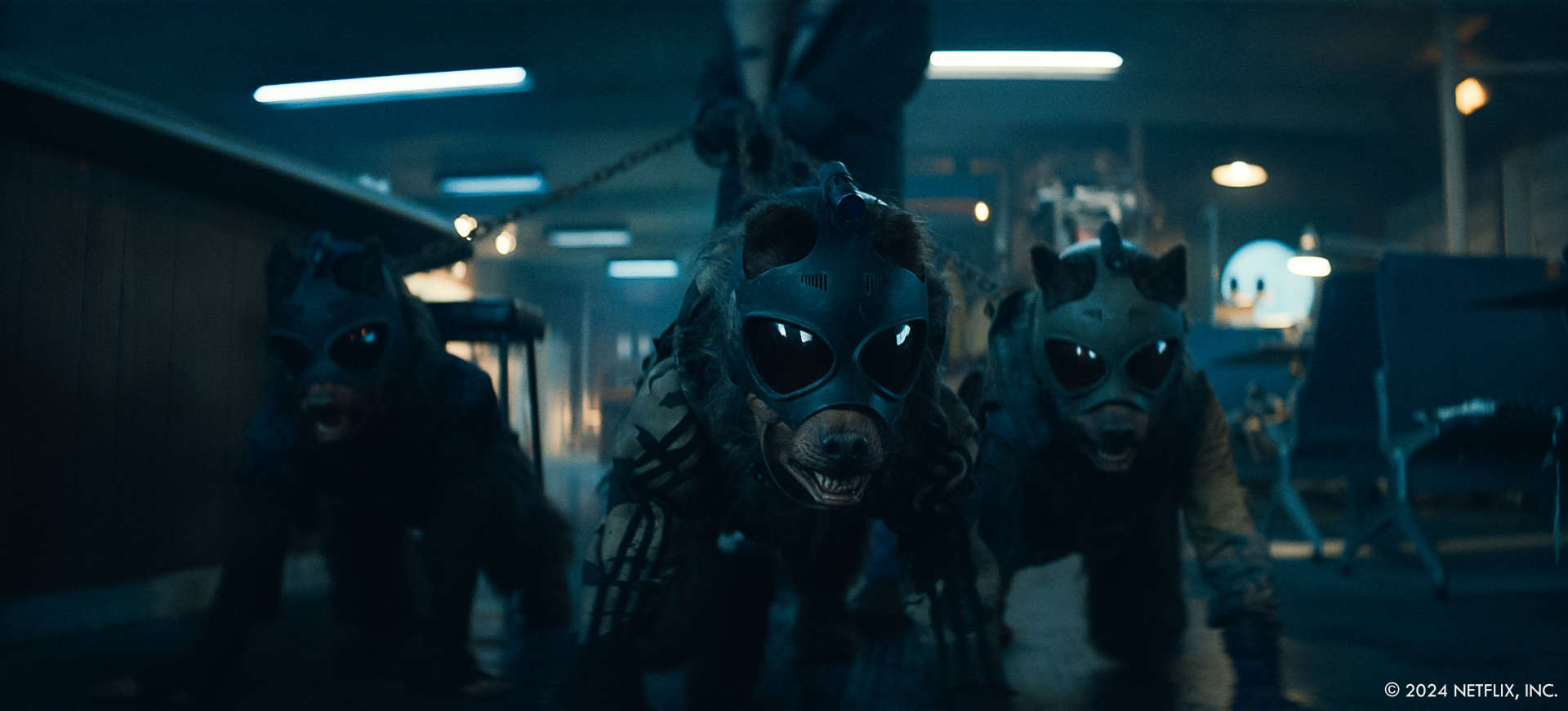
Can you share some insights into the process of integrating visual effects seamlessly with live-action footage?
Rob Price & Danica Tsang // Attention to detail and identifying artifacts within the lensing and lighting of a practical plate is critical. On Sweet Tooth, our first focus was working with the directors and producers to hit the creative challenge. Once approved, we return for a second round of intense quality control with our comping supervisors, Frank Riley and Graeme Baitz, who ensure that all the finer integration details are achieved.
Were there any scenes or effects in the final Season that were particularly challenging to create?
Matt Bramante // One that was a big concern to me early in the process was the scene in 305 when Gus first arrives in Alaska by boat. This was our first introduction to Alaska really at the ground level with Gus, and it needed to be spectacular, and it needed to be outside, and we were shooting it in Auckland in the height of summer. Even the South Island didn’t have snow at this point anywhere below the summit of mt cook. So we knew we had to find another approach. Our designer Nick had an idea to use this old muscle farm on the coast, it had all this great old fishing equipment and even a derelict grounded boat and these big stone pebbles that matched a lot of Alaska coast reference we found. SFX covered the area in environmentally safe foam snow, and we had a couple clean angles looking out to sea or into the equipment all covered in snow. But anything wide looking inland saw the big green hills behind everything. So the Zoic team added a big beautiful mountain range behind all the shots looking toward land. It’s a really nice sequence that does a good job of opening the scope and giving us a nice introduction to Alaska.
Rob Price & Danica Tsang // If so, how did you overcome those challenges? One of the most difficult effects ended up being a simple sweater. Creating a photo-real CG sweater in a close-up, stretching as it is ripped open, led us to procedurally knit a sweater within Houdini to simulate all the fibers coming apart — a more in-depth process than it seems. We now have a CG supervisor who knows how to knit.
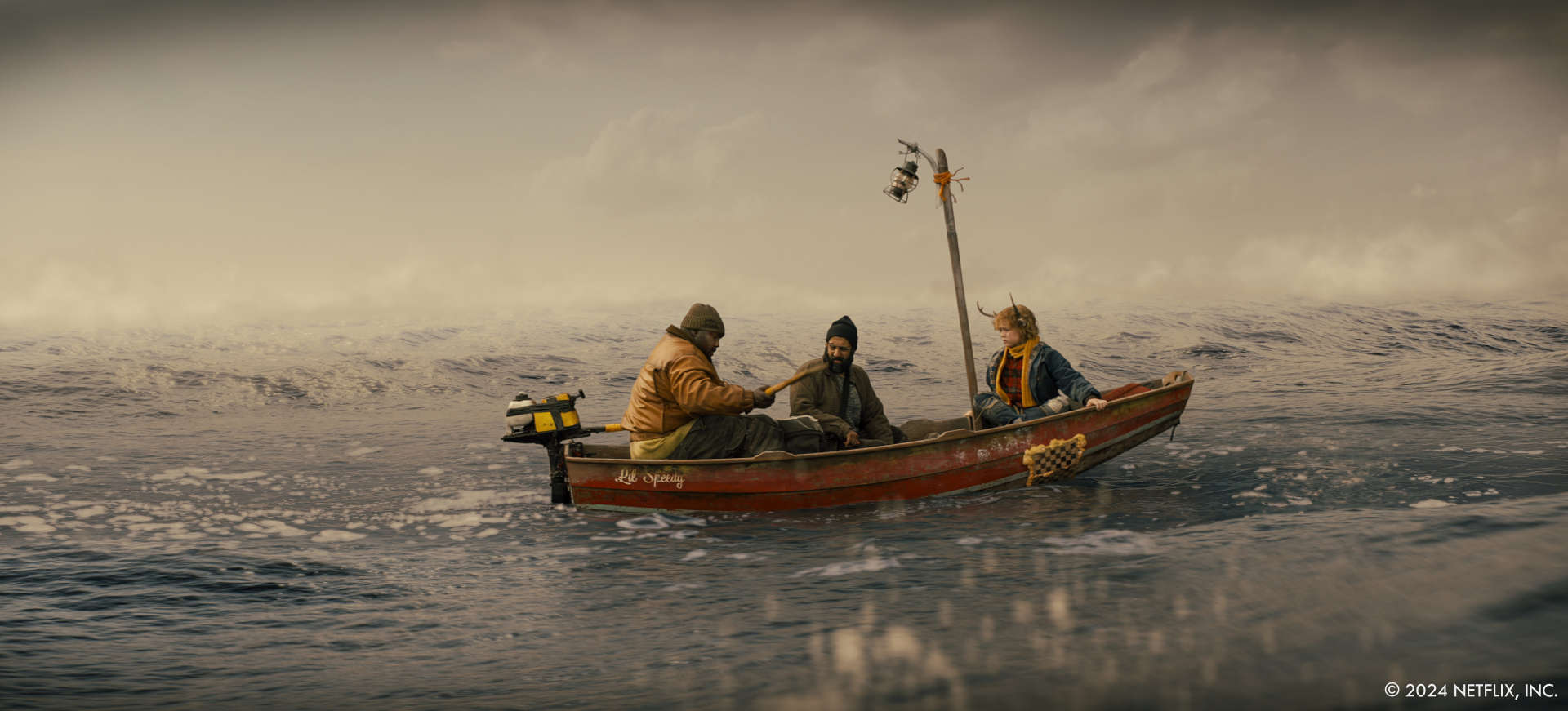
The series blends fantasy elements with realism. How did you maintain this balance in the visual effects?
Matt Bramante // I think our overall approach to the show of looking for practical solutions or photography to start from did a lot of that for us. By keeping the VFX work in a place where it is used to enhance and sweeten what is real and practical, it allowed for very tangible effects work. So any given CG element didn’t feel too unbelievable or fantastical.
Rob Price & Danica Tsang // We always look for how these more fantastic elements can fit into the real world. For example, our owl girl can’t move her eyes just like owls can’t. We determine how a hybrid would move or emote by taking inspiration from the animal with which they are hybridized. This applies to any extensive environment work as well. When the antler tree is consumed by flames, we referenced the way trees burned and smouldered. Although the tree itself has a fantastical design, it still interacts with the world around it according to real world physics.
Were there any fan-favorite visual effects from earlier Seasons that you revisited or expanded upon in the final Season?
Matt Bramante // I think the very end of the show does a nice job of bringing back everybody’s favorite hybrid kids. It’s a nice way of saying good bye to the show, and gives us another chance to see Bobby.
Rob Price & Danica Tsang // We had one last CG Bobby shot at the end of the series finale. We have become very used to our VFX on Sweet Tooth being “invisible”. It’s a little-known fact that there is a CG version of Bobby for scenes where the puppet can’t perform more extensive actions or stunts. Having one last shot was a fitting goodbye to the series for the VFX team.
Did you have to create any new techniques or effects specifically for the final Season?
Matt Bramante // I touched on it a bit before, but I would say the biggest new technique this Season was the addition of miniatures. It’s something we had talked about before, I think at least once per Season the word miniature would come up. But this Season we decided early in prep we wanted to give it a try on the exterior of the church. The set Nick designed for the int was beautiful, this somewhat collapsing old church. And the exterior which was only needed for a couple of shots and would have been too difficult to build at full scale, and if we did build it, we’d have to do a CG environment around it. So we went with a miniature build, which then was comped into a larger environment with snow and atmosphere, and had gus and the hermit shot on green screen comped into it. And it worked really nicely. We even shot a plate of the church for 307 that we put up on the LED wall to get another instance of an in camera VFX solution. We had to get really specific about we could and couldn’t achieve with this, so previs was critical for those scenes, but it’s a nice solution. By the end of the Season we expanded the use of miniatures to include the snowy canyon in 307 and 308, and the beast for the beast chase in 308.
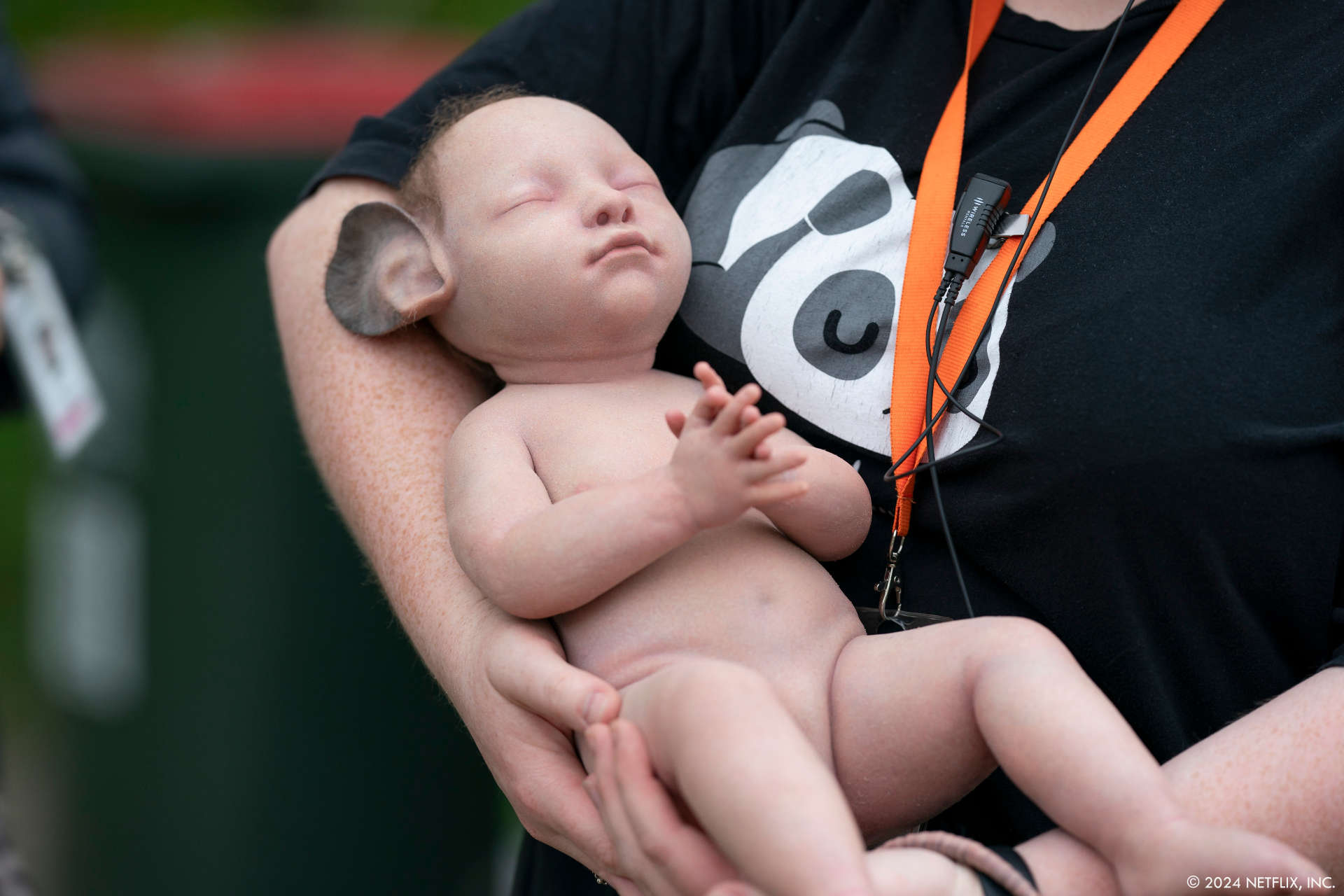
Were there any unexpected technical or creative challenges encountered during the production?
Rob Price & Danica Tsang // Large scale dynamics simulations are always both technically and creatively challenging. For the avalanche sequence, we needed to hit precise timing and scale cues to give us the feeling of such a significant event. This is where having our CG pipeline based inside one package (Houdini) has helped us. The environment, effects, and lighting teams working in concert was vital.
Were there any memorable moments or scenes from the series that you found particularly rewarding or challenging to work on from a visual effects standpoint?
Rob Price & Danica Tsang // I am particularly fond of Daisy the tiger from Season 1. We spent a lot of time developing the asset and I was extremely happy with how she turned out. The animation, fur simulation, and muscle system gave the viewer a visceral reaction for the surprise reveal and really hammered home the story point that this was now a brand new world.
Looking back on the project, what aspects of the visual effects are you most proud of?
Matt Bramante // Sweet Tooth is a complex project, with one of the most ambitious schedules I’ve ever worked. The sheer volume of different types of environments and different types of effects that all needed to be planned and developed and executed on. The scale of that task alone is a huge point of pride. But of course Season 3, for me marks the high water mark of that.
Rob Price & Danica Tsang // I am very proud of the entire body of work, but some of the creature and hybrid work, especially our good friend Bobby, will always have a special place in my heart.
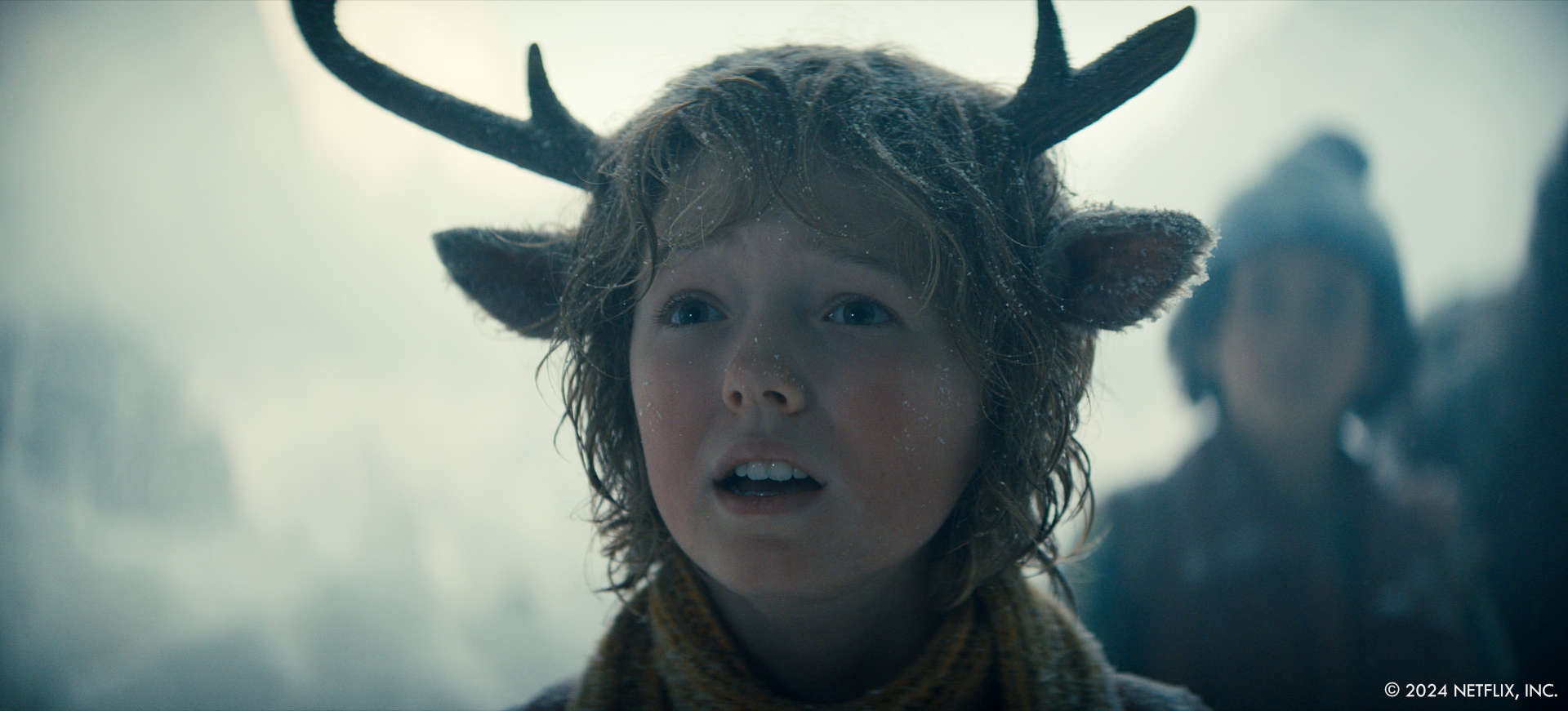
How long have you worked on this show?
Matt Bramante // I first flew to New Zealand August 1st, 2020. There were a few gaps between Seasons, after Season 1 for instance, we waited nearly a full year before Season 2 went. Seasons 2 and 3 were back to back. So about the last three ish years, but with a bit of time on other projects between Seasons.
Rob Price & Danica Tsang // Danica and I started on the pilot in the summer of 2019 and have been on the project for its five-year duration.
What’s the VFX shots count?
Matt Bramante // Zoic had nearly 500 shots according to my records, Rob and Danica can probably elaborate on that. We had another vendor with about 100 shots, another probably 70 in online. And I have a list of a little more than 80 sets using LED walls through the Season. So it’s a large volume of work.
Rob Price & Danica Tsang // We had 475 shots this Season. Over the course of the entire series, we worked on just under 2300 shots.
What is your next project?
Matt Bramante // I just finished filming and am a couple weeks into post on a feature film named The Woman in the Yard for Blumhouse, directed by Jaume Collet-Serra.
Rob Price & Danica Tsang // Danica and I are currently working on an A24 film, Death of a Unicorn.
A big thanks for your time.
© Vincent Frei – The Art of VFX – 2024
Get ready to witness Zack Snyder‘s Rebel Moon like never before. The Director’s Cut brings an intense and breathtaking experience with epic battles and stunning visuals!
The VFX are made by:
Framestore (VFX Supervisors: Robert Winter, Bryan Litson)
Luma Pictures (VFX Supervisors: Farhad Mohasseb, Brendan Seals)
Mammal Studios (VFX Supervisor: Gregory D. Liegey)
Rodeo FX (VFX Supervisor: Mai-Ling Dydo)
Scanline VFX (VFX Supervisors: Justin Mitchell, Julius Lechner)
Weta FX (VFX Supervisors: Ken McGaugh, Robin Hollander)
The Production VFX Supervisor is Marcus Taormina.
The Additional Production VFX Supervisor is John “DJ” DesJardin.
The Production VFX Producer is Tamara Watts Kent.
Director: Zack Snyder
Release Date: August 2, 2024 (USA)


© Vincent Frei – The Art of VFX – 2024
Discover the origins of the Bene Gesserit in Dune: Prophecy. Set millennia before the rise of Paul Atreides, this epic journey follows two Harkonnen sisters as they shape the future of the universe.
The VFX are made by:
Important Looking Pirates
Accenture Song VFX
Image Engine
Raynault VFX
Rodeo FX
The Resistance
Futureworks
Territory Studio
The Production VFX Supervisor is Michael Enriquez.
The Additional VFX Supervisor is Brennan Prevatt.
The Production VFX Producer is Terron Pratt.
Showrunner: Alison Schapker
Release Date: Fall 2024 (HBO Max)
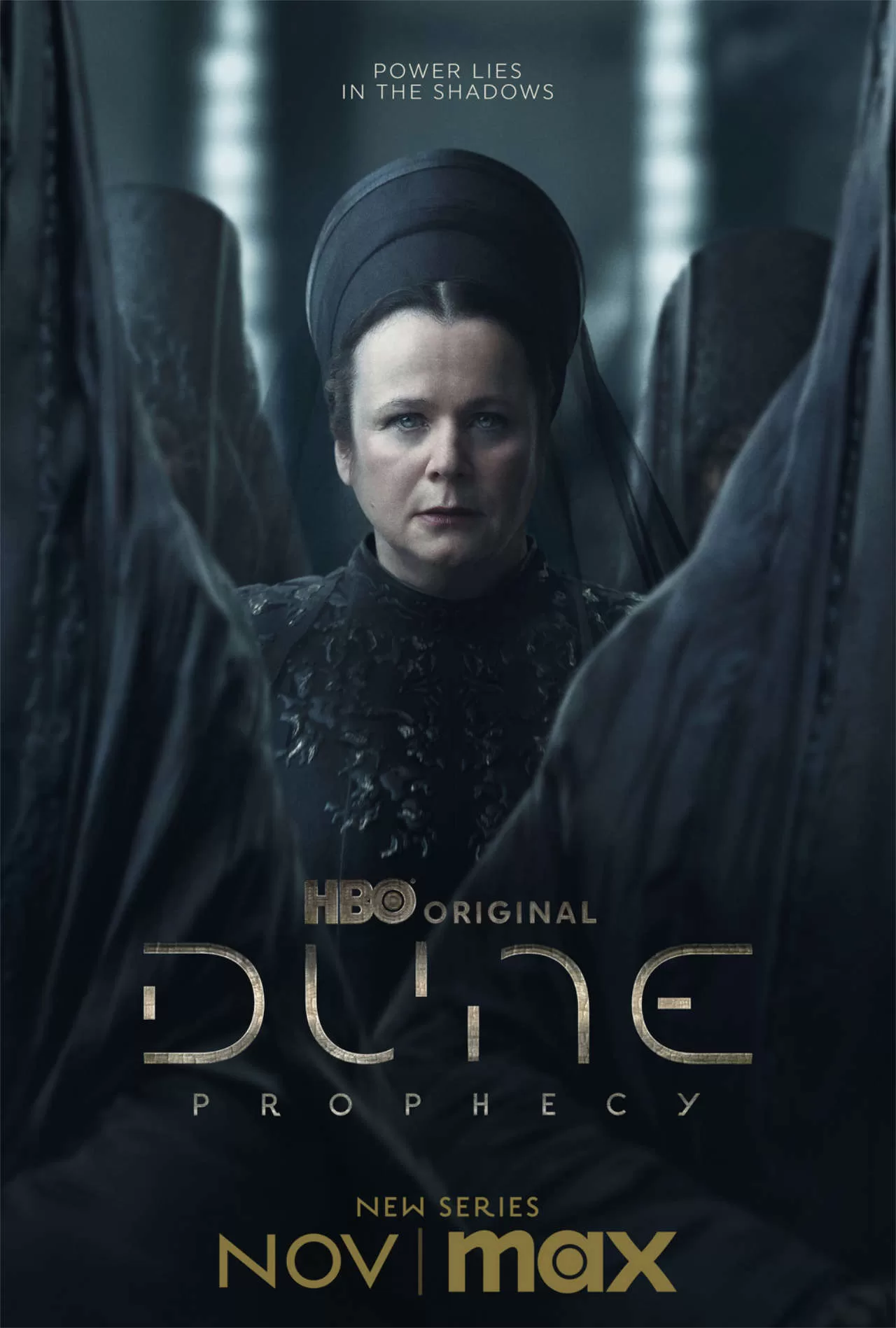
© Vincent Frei – The Art of VFX – 2024